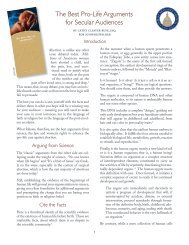The Effects of Divorce on Children - Family Research Council
The Effects of Divorce on Children - Family Research Council
The Effects of Divorce on Children - Family Research Council
You also want an ePaper? Increase the reach of your titles
YUMPU automatically turns print PDFs into web optimized ePapers that Google loves.
aises children’s likelihood <str<strong>on</strong>g>of</str<strong>on</strong>g> divorce: 161 <strong>Children</strong> who have experienced parental<br />
divorce are more than twice as likely to divorce, compared with children <str<strong>on</strong>g>of</str<strong>on</strong>g> intact<br />
families. 162 One study found that adults who experience parental divorce have<br />
chances <str<strong>on</strong>g>of</str<strong>on</strong>g> divorce 38 percent higher than adults raised in intact families.<br />
Significantly, this increase is not seen in children whose parents’ marriage ended<br />
because <str<strong>on</strong>g>of</str<strong>on</strong>g> the death <str<strong>on</strong>g>of</str<strong>on</strong>g> <strong>on</strong>e <str<strong>on</strong>g>of</str<strong>on</strong>g> the parents. 163<br />
<strong>Children</strong> <str<strong>on</strong>g>of</str<strong>on</strong>g> divorce are 39 percent more likely to marry other children <str<strong>on</strong>g>of</str<strong>on</strong>g> divorce,<br />
after c<strong>on</strong>trolling for educati<strong>on</strong>. Couples with <strong>on</strong>e spouse from a divorced home are<br />
nearly twice as likely to divorce as couples with both spouses from n<strong>on</strong>-divorced<br />
families. Worse still, couples with both spouses from divorced families over three<br />
times more likely to divorce than couples with both spouses from n<strong>on</strong>-divorced<br />
families. 164<br />
<strong>Children</strong> who experience three or more transiti<strong>on</strong>s in family structure are much<br />
more likely to divorce later in life, compared to children who did not experience<br />
such family transiti<strong>on</strong>s. 165 That is, 59 percent <str<strong>on</strong>g>of</str<strong>on</strong>g> the individuals who have never<br />
161 Jay D. Teachman, “Childhood Living Arrangements and the Intergenerati<strong>on</strong>al Transmissi<strong>on</strong> <str<strong>on</strong>g>of</str<strong>on</strong>g><br />
<str<strong>on</strong>g>Divorce</str<strong>on</strong>g>,” Journal <str<strong>on</strong>g>of</str<strong>on</strong>g> Marriage and <strong>Family</strong> 64 (2002): 717-729.<br />
Nicholas H. Wolfinger, “Bey<strong>on</strong>d the Intergenerati<strong>on</strong>al Transmissi<strong>on</strong> <str<strong>on</strong>g>of</str<strong>on</strong>g> <str<strong>on</strong>g>Divorce</str<strong>on</strong>g>: Do People<br />
Replicate the Patterns <str<strong>on</strong>g>of</str<strong>on</strong>g> Marital Instability <str<strong>on</strong>g>The</str<strong>on</strong>g>y Grew Up With?” Journal <str<strong>on</strong>g>of</str<strong>on</strong>g> <strong>Family</strong> Issues 21<br />
(2000): 1061-1086.<br />
Joan S. Tucker, Howard S. Friedman, Joseph E. Schwartz, Michel H. Criqui, Carol Tomlins<strong>on</strong>-<br />
Keasey, Deborah L. Wingard, and Leslie R. Martin, “Parental <str<strong>on</strong>g>Divorce</str<strong>on</strong>g>: <str<strong>on</strong>g>Effects</str<strong>on</strong>g> <strong>on</strong> Individual<br />
Behavior and L<strong>on</strong>gevity,” Journal <str<strong>on</strong>g>of</str<strong>on</strong>g> Pers<strong>on</strong>ality and Social Psychology 73 (1997): 385-386.<br />
Paul R. Amato, “Explaining the Intergenerati<strong>on</strong>al Transmissi<strong>on</strong> <str<strong>on</strong>g>of</str<strong>on</strong>g> <str<strong>on</strong>g>Divorce</str<strong>on</strong>g>,” Journal <str<strong>on</strong>g>of</str<strong>on</strong>g><br />
Marriage and <strong>Family</strong> 58 (1996): 628-640.<br />
Verna M. Keith and Barbara Finlay, “<str<strong>on</strong>g>The</str<strong>on</strong>g> Impact <str<strong>on</strong>g>of</str<strong>on</strong>g> Parental <str<strong>on</strong>g>Divorce</str<strong>on</strong>g> <strong>on</strong> <strong>Children</strong>’s<br />
Educati<strong>on</strong>al Attainment, Marital Timing, and Likelihood <str<strong>on</strong>g>of</str<strong>on</strong>g> <str<strong>on</strong>g>Divorce</str<strong>on</strong>g>,” Journal <str<strong>on</strong>g>of</str<strong>on</strong>g> Marriage and<br />
<strong>Family</strong> 50 (1988): 797-809.<br />
Norval D. Glenn and Kathryn B. Kramer, “<str<strong>on</strong>g>The</str<strong>on</strong>g> Marriages and <str<strong>on</strong>g>Divorce</str<strong>on</strong>g>s <str<strong>on</strong>g>of</str<strong>on</strong>g> the <strong>Children</strong> <str<strong>on</strong>g>of</str<strong>on</strong>g><br />
<str<strong>on</strong>g>Divorce</str<strong>on</strong>g>,” Journal <str<strong>on</strong>g>of</str<strong>on</strong>g> Marriage and <strong>Family</strong> 49 (1987): 811-825.<br />
Sara McLanahan and Larry Bumpass, “Intergenerati<strong>on</strong>al C<strong>on</strong>sequences <str<strong>on</strong>g>of</str<strong>on</strong>g> <strong>Family</strong> Disrupti<strong>on</strong>,”<br />
American Journal <str<strong>on</strong>g>of</str<strong>on</strong>g> Sociology 94 (1988): 130-152.<br />
Paul R. Amato and Brian Keith, “Parental <str<strong>on</strong>g>Divorce</str<strong>on</strong>g> and Adult Well-being: A Meta-Analysis,”<br />
Journal <str<strong>on</strong>g>of</str<strong>on</strong>g> Marriage and <strong>Family</strong> 53 (1991): 43-58.<br />
Paul R. Amato and Danelle D. DeBoer, “<str<strong>on</strong>g>The</str<strong>on</strong>g> Transmissi<strong>on</strong> <str<strong>on</strong>g>of</str<strong>on</strong>g> Marital Instability across<br />
Generati<strong>on</strong>s: Relati<strong>on</strong>ship Skills or Commitment to Marriage?” Journal <str<strong>on</strong>g>of</str<strong>on</strong>g> Marriage and the<br />
<strong>Family</strong> 63 (2001): 1054.<br />
162 Pamela S. Webster, Terri L. Orbuch, and James S. House, “<str<strong>on</strong>g>Effects</str<strong>on</strong>g> <str<strong>on</strong>g>of</str<strong>on</strong>g> Childhood <strong>Family</strong><br />
Background <strong>on</strong> Adult Marital Quality and Perceived Stability,” American Journal <str<strong>on</strong>g>of</str<strong>on</strong>g> Sociology<br />
101 (1995): 404-432.<br />
163 Jay D. Teachman, “Childhood Living Arrangements and the Intergenerati<strong>on</strong>al Transmissi<strong>on</strong> <str<strong>on</strong>g>of</str<strong>on</strong>g><br />
<str<strong>on</strong>g>Divorce</str<strong>on</strong>g>,” Journal <str<strong>on</strong>g>of</str<strong>on</strong>g> Marriage and the <strong>Family</strong> 64 (2002): 722.<br />
164 Nicholas H. Wolfinger, “<strong>Family</strong> Structure Homogamy: <str<strong>on</strong>g>The</str<strong>on</strong>g> <str<strong>on</strong>g>Effects</str<strong>on</strong>g> <str<strong>on</strong>g>of</str<strong>on</strong>g> Parental <str<strong>on</strong>g>Divorce</str<strong>on</strong>g> <strong>on</strong><br />
Partner Selecti<strong>on</strong> and Marital Stability,” Social Science <strong>Research</strong> 32 (2003): 91-92.<br />
165 Nicholas H. Wolfinger, “Bey<strong>on</strong>d the Intergenerati<strong>on</strong>al Transmissi<strong>on</strong> <str<strong>on</strong>g>of</str<strong>on</strong>g> <str<strong>on</strong>g>Divorce</str<strong>on</strong>g>: Do People<br />
Replicate the Patterns <str<strong>on</strong>g>of</str<strong>on</strong>g> Marital Instability <str<strong>on</strong>g>The</str<strong>on</strong>g>y Grew Up With?” Journal <str<strong>on</strong>g>of</str<strong>on</strong>g> <strong>Family</strong> Issues<br />
21, no. 8 (2000): 1074.<br />
24




